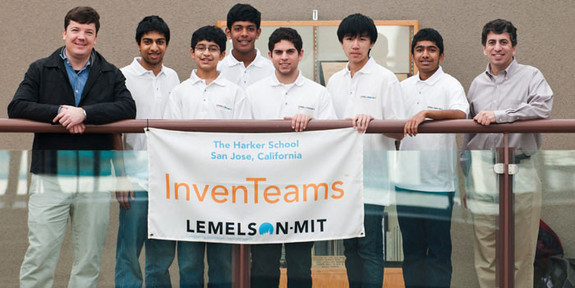Students' Device Taps Swimming Pool for Power

Most American teens may see a pool as a chance for a swim or lazy summer relaxation, but one group of California high school students envisions swimming pools as a new source of electricity to power U.S. schools, homes and businesses.
Their energy solution relies upon the power of thermoelectric panels capable of harnessing the temperature difference between a hot surface and the cold water. That could do much more than just power household devices — huge floating farms of the devices might create electricity for energy-hungry coastal towns and cities.
"As this device floats on water, reflector panels focus sunlight onto a black surface that converts the solar energy to heat," said Anthony Silk, a math teacher and adviser to the Harker School team in San Jose, Calif. "This heat is then passed through thermoelectric panels and passively dissipated into the surrounding water."
The sophomores, juniors and seniors on the Harker School InvenTeam saw thermoelectric devices as a way of tapping into "the graveyard" of heat energy that usually ends up wasted. They also realized that water could act as the ideal cooling source to offset sun-warmed material and create the temperature difference needed for the thermoelectric panels.
"Our first thoughts incorporated thermoelectrics into clothing and around computers," Silk told InnovationNewsDaily. "But as we progressed, we sought to harness the most basic gradient between the sun and water."
The student team set out to make their first device for school swimming pools, and soon ended up balancing ideal designs against budget limits. They cut the number of panels they originally wanted by half, but were able to buy off-the-shelf thermoelectric panels. Soltec, a maker of solar absorbent coating, sent samples to help maximize the amount of heat absorbed by the device.
Most recently, the students represented one of 14 student teams participating in the Open Minds exhibition held by the National Collegiate Inventors and Innovators Alliance at the Exploratorium museum in San Francisco on March 23. They had received an invitation from the NCIIA and Lemelson-MIT Program.
Sign up for the Live Science daily newsletter now
Get the world’s most fascinating discoveries delivered straight to your inbox.
"As inventors, we look forward to getting feedback about our device and potentially even obtaining further sponsorship and funding from venture capitalists ," Silk explained before the event. "We are also interested in taking a look at the other inventors and their devices for inspiration on how to improve our device further."
Future tests include changing the angles of the sunlight reflectors to boost power generation. The team also wants to try out a transparent Lexan plastic pyramid to see whether it prevents enough heat loss to offset the limits on sunlight reaching the device's heat-absorbing surface.
A finished product should be ready by the time of the EurekaFest held at MIT in June, Silk said. The team has a $9,110 grant from the Lemelson-MIT Program's InvenTeam initiative, and is being sponsored by Lenyard Food Service for the trip to EurekaFest.
The Harker School InvenTeam suggested that fellow inventors should "plan, commit and execute" to succeed. Having a timeline has helped keep the team focused on the task, even if certain details of the invention have evolved over time.
"You have to give your heart and soul into the project," Silk said. "This includes sacrificing playing video games and hanging out with friends to work on your project. You have to be thinking about the subject 24-7."
This story was provided by InnovationNewsDaily, a sister site to LiveScience. You can follow InnovationNewsDaily Senior Writer Jeremy Hsu on Twitter @ScienceHsu. Follow InnovationNewsDaily on Twitter @News_Innovation, or on Facebook.










